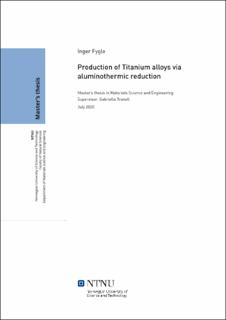| dc.contributor.advisor | Tranell, Gabriella | |
| dc.contributor.author | Fygle, Inger | |
| dc.date.accessioned | 2021-09-28T18:05:50Z | |
| dc.date.available | 2021-09-28T18:05:50Z | |
| dc.date.issued | 2020 | |
| dc.identifier | no.ntnu:inspera:59547306:14561356 | |
| dc.identifier.uri | https://hdl.handle.net/11250/2785270 | |
| dc.description.abstract | Titan metall har blitt produsert og fremstilt på kommersiell skala siden begynnelsen av 1950-tallet på grunn av dets unike egenskaper: (i) høyt styrke-til-vekt forhold, (ii) forhøyet smeltepunkt, og (iii) utmerket korrosjonsbestandighet i forskjellige tøffe kjemiske miljø. Titan sponge produseres industrielt over hele verden med Kroll prosessen, som består av metallotermisk reduksjon av TiCl4(g) med rent magnesium metal. Selv om denne prosessen er forbedret siden den første industriproduksjonen, har den fortsatt flere ulemper som den ineffektive kontakten mellom reaktantene og bruken av det flyktige og etsende TiCl4. Som et resultat av dette har enklere og billigere produksjonsmetoder blitt studert siden tidlig 1970. En av de alternative metodene som har blitt studert og viser potensial er aluminotermisk reduksjon av TiO2. I dette studiet har bruken av aluminotermisk reduksjons prosess for å produsere Ti-legeringer fra TiO2- og SiO2 holdig slag blitt studert.
To ulike slagger ble laget i en induksjonsovn, 18wt%CaO-82wt%TiO2 og 50wt%CaO-25wt%SiO2-25wt%TiO2, mens eksperimentene med aluminotermisk reduksjon ble utført i en vakuuminduksjonsovn. 12 forsøk ble utført total, 6 med hver slag. Holdetiden for reduksjonen var 1 time for alle eksperimentene, mens to ulike holdetemperaturer ble brukt, henholdsvis 1550°C og 1650°C. Mengden aluminium tilsatt ble variert mellom 80%, 100% og 120% støkiometrisk med hensyn til mengde TiO2 og SiO2 i slaggen med tanke på å redusere all TiO2 og SiO2. Etter avkjøling i ovn ble den reagerte slaggen og det reagerte metallet kuttet, støpt og deretter karakterisert og analysert med SEM, EDS, EPMA, XRD og ICP-MS.
Resultatene fra det reagerte metallet og slaggen fra forsøkene med den binære slaggen viste at det var litt eller svært lite titan i metallet, mens mengden TiO2 i slaggen var høy. XRD analysere av slaggen viste dannelse av Ti2O3 og TiO noe som forklarte hvorfor det ikke ble observert noe Ti i metallet.
Resultatene fra det reagerte metallet og slaggen fra forsøkene med den ternære slaggen viste nesten 100wt% av Ti og Si i metallet, mens mengden TiO2 i slaggen var svært liten. Innholdet av Ti i metallet minket med økende mengde av tilsatt Al, og en tilsvarende økning av innholdet av Al i metallet ble observert. Observasjon av SiO2 i slaggen, kombinert med at innholdet av Si i metallet var lavere enn Ti implementerer at den termodynamiske prioriteringen av reduksjon med Al er TiO2>SiO2. | |
| dc.description.abstract | Titanium metal has been produced and manufactured on a commercial scale since the early 1950s for its unique set of properties: (i) high strength-to-weight ratio, (ii) elevated melting point, and (iii) excellent corrosion resistance in various harsh chemical environments. Titanium sponge is produced industrially worldwide by the Kroll process, which consists of the metallothermic reduction of gaseous titanium tetrachloride with pure magnesium metal. Even if the Kroll process has been improved since its first industrial production, it still exhibits several drawbacks. Like the ineffective contact between reactants and the use of the volatile and corrosive titanium tetrachloride as the dominant feed. As a result, easier and cheaper production methods have been studied since the early 1970s. One of the alternative processes that has been considered and is showing potential is the aluminothermic reduction of TiO2. In this study, the use of an aluminothermic reduction process to produce titanium alloys from titania-silica containing slags has been studied.
Two different slags were made in an induction furnace, 18wt%CaO-82wt%TiO2 and 50wt%CaO-25wt%SiO2-25wt%TiO2, while the aluminothermic reduction experiments were performed in a vacuum induction furnace. 12 experiments were performed in total, 6 for each slag. Holding time for the aluminothermic reduction was 1h for all the experiments, while two different holding temperatures were used, 1550°C and 1650°C respectively. The aluminium added was varied between 80%, 100% and 120% stoichiometric with respect to the amount of TiO2 and SiO2 in the slag, with the intention of reducing all TiO2 and SiO2. After cooling in the furnace, the reacted slag and metal were cut, cast and then characterized and analyzed with scanning electron microscopy (SEM), energy dispersive spectroscopy (EDS), electron probe micro-analyzer (EPMA), x-ray powder diffraction (XRD) and inductively coupled plasma mass spectroscopy (ICP-MS).
Results from the reacted metal and slag from the experiments with the binary slag showed that there was none or minimal amount of Ti in the metal. In contrast, the amount of TiO2 in the reacted slag was high. XRD analysis showed the formation of TixOy in the reacted slag, which explained why no Ti was detected in the reacted metal.
Results from the reacted metal and slag from the experiments with the ternary slag showed high concentrations of both Ti and Si in the metal, while the amount of TiO2 was close to 0wt% in the reacted slag. The concentration of Ti in the reacted metal decreased with increased addition of Al, while a corresponding increase in the concentration of Al in the metal was observed. Observations of SiO2 in the slag combined with the concentration of Si in the metal being lower than the concentration of Ti implied that the thermodynamic priority of reduction by Al is TiO2>SiO2. | |
| dc.language | | |
| dc.publisher | NTNU | |
| dc.title | Production of Titanium alloys via aluminothermic reduction | |
| dc.type | Master thesis | |
